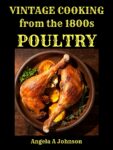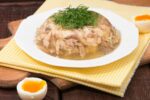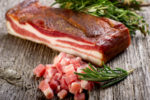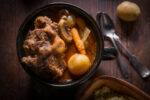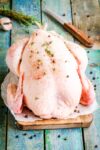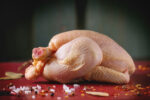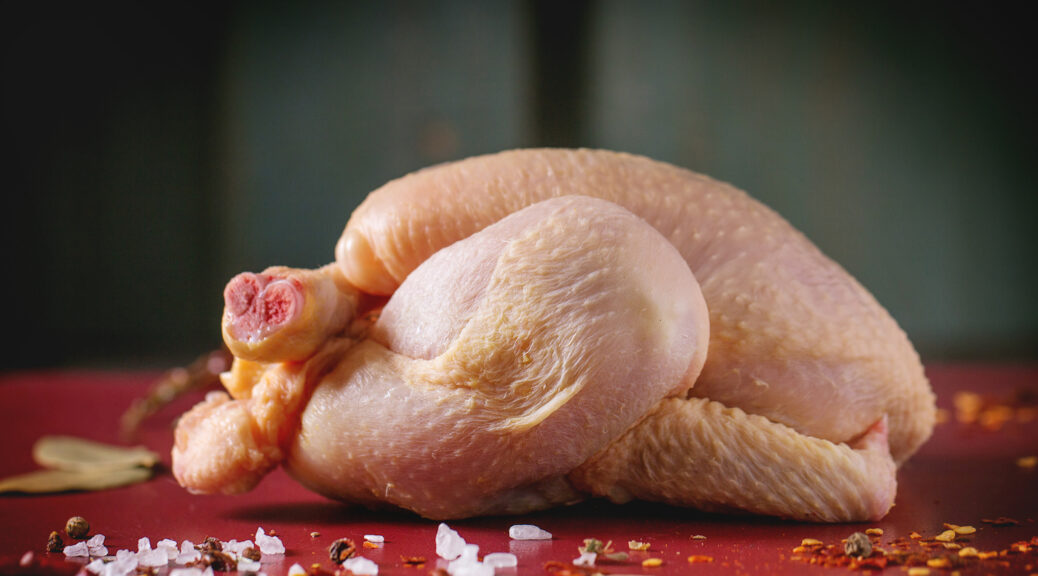
How to Select Fresh Poultry at the Market
In the 1800s, people who didn’t raise their own poultry usually bought their meat from a butcher shop. There was no electric refrigeration and no government inspections, so they bought from a reputable butcher or learned to determine a fowl’s freshness themselves. Poultry was usually sold as a whole bird.
INFORMATION BELOW FROM 1800s COOKBOOKS
It is necessary to know the difference between fowls and birds. A fowl always leads its young ones to the meat, and a bird carries the meat to its young.
So our common poultry are fowls; the pheasant, partridge, peacock, turkey, quail, duck, chickens, and such.
FREEDOM FROM DISEASE
The first care in the selection of poultry should be its freedom from disease. Birds deprived of exercise, shut up in close cages, and regularly stuffed with as much corn or soft food as they can swallow may possess the requisite fatness, but it is of a most unwholesome character.
When any living creature ceases to exercise, its excretory organs cease to perform their functions thoroughly, and its body becomes saturated with retained excretions.
A stall-fed fowl may be recognized by the color of its fat, which is pale white and lies in thick folds beneath the skin along the lower half of the backbone. The surface of the body presents a more greasy, uninviting appearance than fowls permitted to live under natural conditions.
UNDRAWN FOWLS
Never purchase fowls which have been sent to the market undrawn.* All animals intended for use as food should be dressed as quickly as possible after killing. Putrefactive changes begin very soon after death, and the liver and other viscera, owing to their soft texture and to the quantity of venous blood they retain, advance rapidly in decomposition.
Poultry should be entirely free from disagreeable odors. Methods are employed for sweetening fowls which have been kept too long in market, but if they need such attention, bury them decently rather than cook them for the table.
*draw – to remove the entrails (internal organs); as to draw a chicken.
TO SELECT POULTRY
In selecting poultry, choose those that are full grown, but not old. When young and fresh-killed, the skin is thin and tender, the joints not very stiff, and the eyes full and bright.
The breast of all birds should be full and plump. Birds which are diseased always fall away on the breast, and the bone feels sharp and protrudes. The breast-bone shows the age, as it easily yields to pressure if young, and is tough when old. If young, you can easily tear the skin with a pin. This is sometimes broken in fowls to deceive purchasers, but the difference between a broken bone that slips when moved, and a soft yielding cartilage may be very easily detected.
Turn the wing back, and if the sinews snap, it is a sign the chicken is young.
Pin-feathers are the roots of feathers, which break off and remain in the skin and always indicate a young bird. When very neatly dressed, they are pulled out. An older bird has long hairs.
CHICKENS
Poultry should have just reached their full growth. A hen is at her best just before she begins to lay. Her legs should be smooth, her comb small, bright, and soft. A young cock has the comb full, bright colored and smooth, the legs smooth, and the spurs short. In both, the toes should break easily when turned back. The weight of the birds should be great in proportion to their size. They also require longer cooking in proportion to their size, and never should be underdone.The breast should be full, the lean meat white, and the fat a pale straw color. Chickens are best in the last of the summer and the fall and winter.
Spring chickens bring a high price and are considered delicacies, but they are so insipid and have so little on them, the purchase of them is a mere fashionable extravagance and a waste of money. It is better to wait till the young chickens grow into nice plump fowls that were well fed, and have lived long enough to show it.
TURKEYS
The best turkeys have smooth black legs, with soft, loose spurs. The lower end of the breast-bone should be soft and bend easily, the breast plump and short, the meat firm, and the fat white. When the bird is very large and fat, the flavor is sometimes a little strong. Eight or ten pounds is a good size for a small family.
DUCKS
Young ducks are plump with light, semi-transparent fat, a soft breast-bone, tender flesh, and leg-joints which will break by the weight of the bird. They have fresh-colored and brittle beaks, and windpipes that break when pressed between the thumb and forefinger. They feel tender under the wing, and the web of the foot is transparent. Wild ducks have reddish feet and tame ducks have thick yellowish feet. Ducks are best in fall and winter.
GEESE
There is more deception in geese than in any other kind of poultry. Geese are generally kept alive too long for the sake of their feathers, which they always shed in August, and for which there is always a demand. Geese are not expensive to keep, as in summer they feed on grass and will graze in a field like sheep.
Geese live to a great age–thirty or more years. They are not good when more than three years old. Young geese have yellow bills, and the feet are yellow and supple. The skin may be easily broken by the head of a pin, the breast is plump, and the fat white.
In a young goose, the cavity under the wings is very tender. It is a bad sign if you cannot, with very little trouble, push your finger directly into the flesh. If the wind pipe is brittle and breaks easily under pressure of the finger and thumb, the bird is young, but if it rolls, the bird is old.
A young goose has pin feathers and its flesh is whiter than that of an old one. You may also judge the age of a goose by the thickness of the web between the toes. When young, this is tender and transparent; it grows coarser and harder with time. The feet and legs of an old goose are red and hard. So is her bill. The skin is rough, coarse, and tough, and full of hairs.
Let nothing induce you to buy an old goose. You would find it too tough to carve and too tough to eat. And no cooking can make her tender. An old goose is unfit for the human stomach. Geese are in season in the fall and winter.
